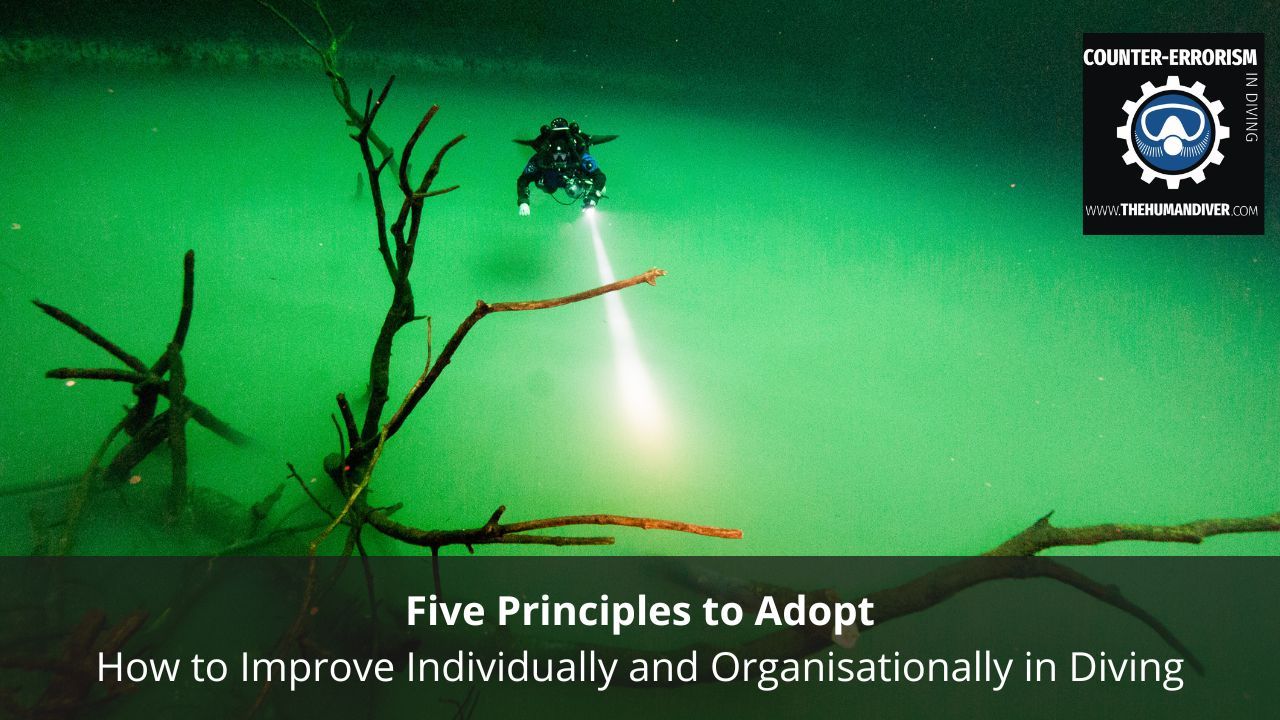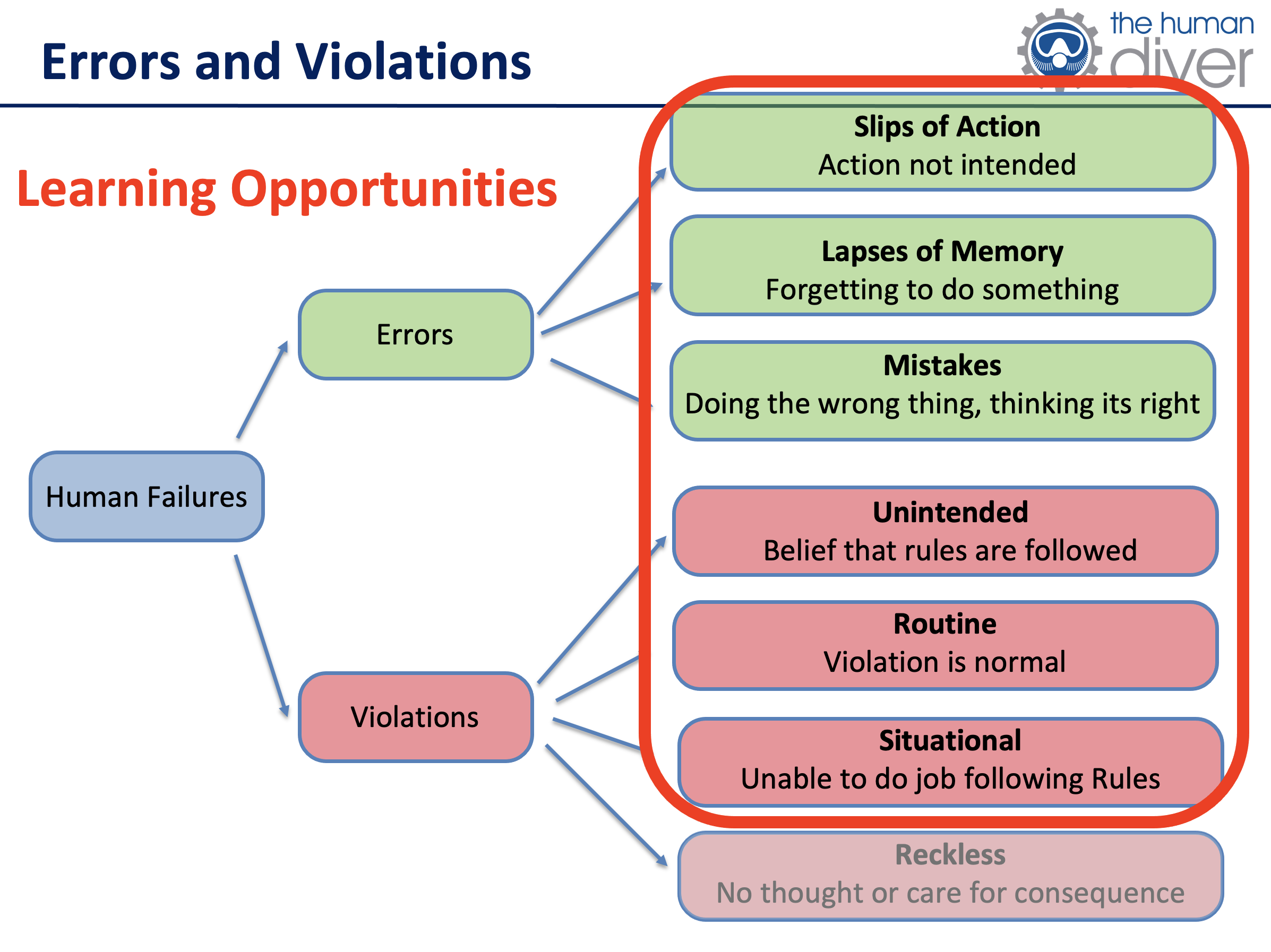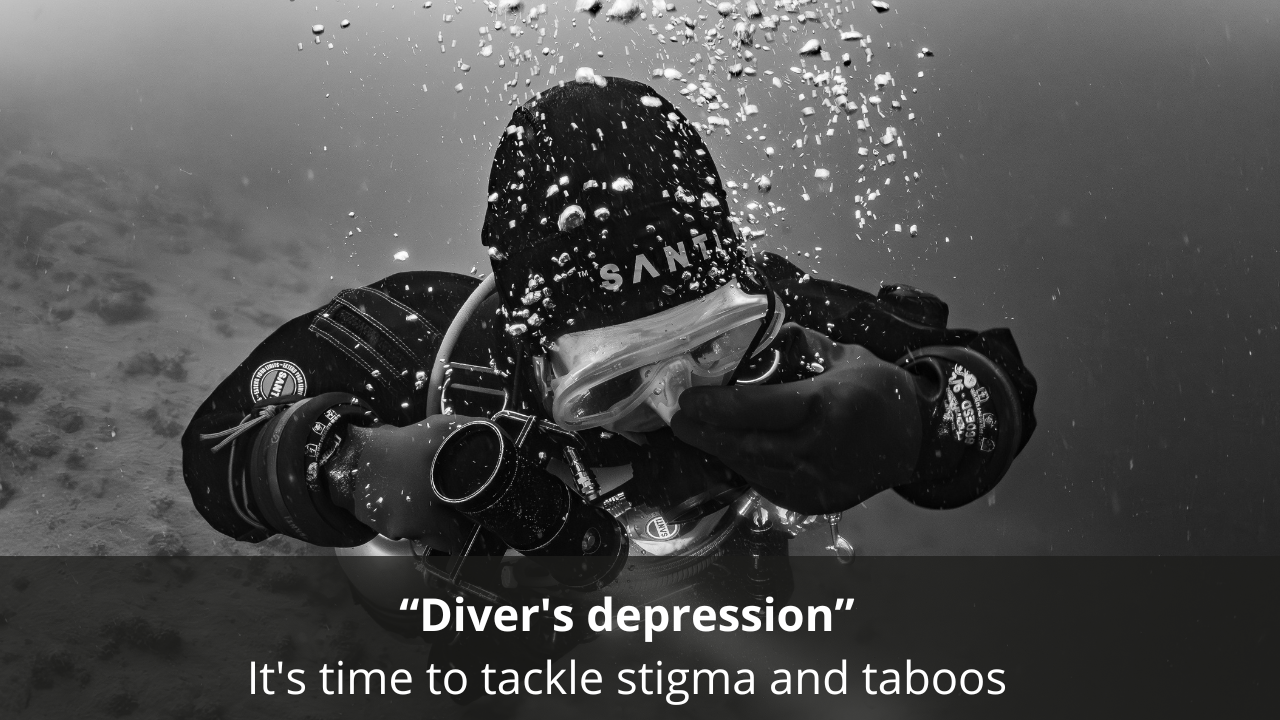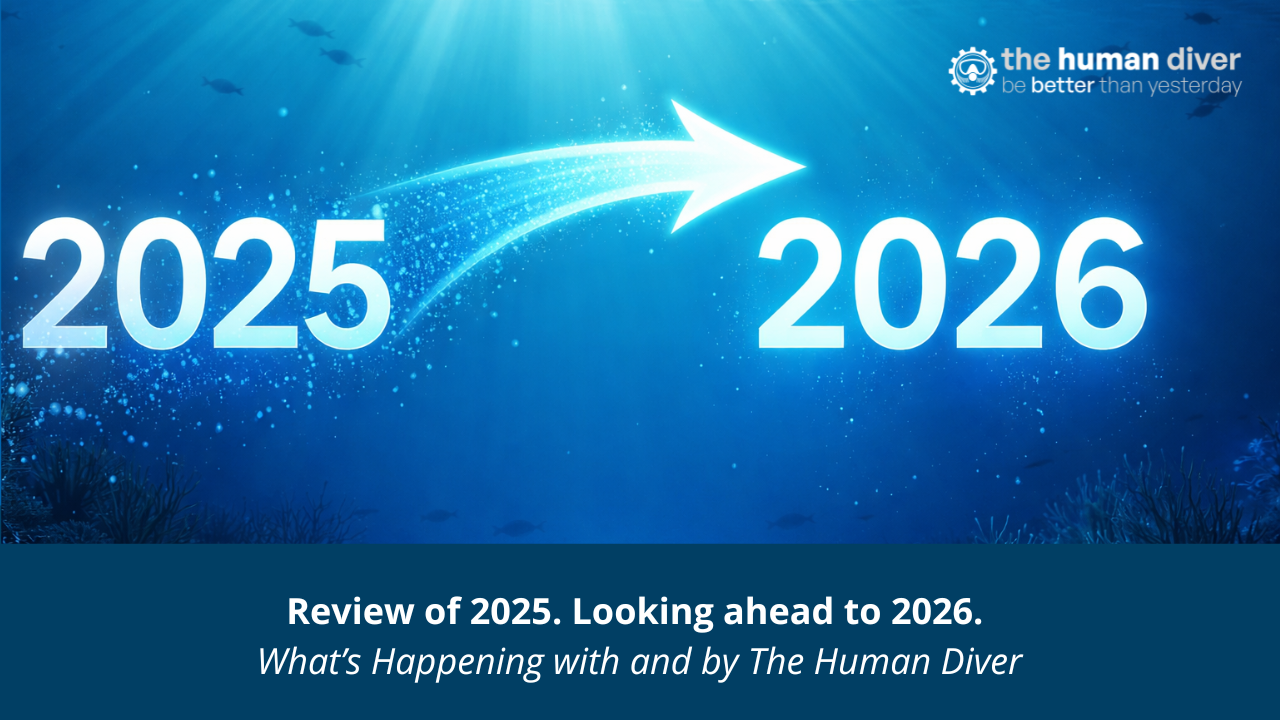
Five Key Principles to Adopt: How to Improve Individually and Organisationally
Feb 26, 2023"Aviation in itself is not inherently dangerous. But, to an even greater degree than the sea, it is terribly unforgiving of any carelessness, incapacity or neglect." The same goes for diving. And for the nuclear industry. So how have aviation and nuclear become so safe and what can diving learn from them? You might think I’m going to talk about regulation and structure, but I’m not. I am going to talk about five key principles which look at the humans in the system, and the system itself. These principles relate to Human and Organisational Performance, often called HOP, but is better referred to as H&OP because of the influence that organisations have on individuals.
The five principles are:
- Human error is normal.
- Blame adds no value to learning.
- Context drives behaviour.
- How leaders respond matters.
- Learning is vital for improvement.
and I’m going to provide a brief overview of each principle. This week, there will be five videos shown in the Human Factors in Diving Facebook group here – https://www.facebook.com/groups/184882365201810/ - which will cover the principles in a little more detail and how they can apply to diving.
The principles originated as thought leaders in the safety industry (Conklin, Reason, Dekker, Hollnagel and others) recognised that while you can’t fix the human for their variable performance, you can design systems (technical and social) that make it easier to do the right thing and harder to do the wrong thing and that when mistakes do happen, the approach needs to be curious, not judgemental. Equally as important, organisations should look to prevent events from occurring in the first place by understanding ‘Work as Done’ and comparing it to ‘Work as Imagined’, and accepting that 'Work as Imagined' will not match the operating environment, so expecting compliance is flawed.
As you read through these principles, you should start to recognise their interdependence. Where possible, links to existing Human Diver blogs will be provided to show how these topics aren’t new but look at things from a slightly different perspective.

I forgot to check the focus setting on the camera before I entered the water. Great photo. Out of focus!
Principle 1: Human error is normal
‘Human error’ is a useless term when it comes to learning, and yet it is used in many diving incident reports. The reason why an error isn’t a useful term is because it is so prevalent, and most of the time when errors are made, they don’t end up with something going wrong. It is said that pilots make between 3-6 errors per hour on the flight deck, but because they know they are prevalent, they trap them before they become critical. Simply, an error is an unintended deviation from a preferred behaviour. This could be forgetting to analyse gas because the diver was distracted, entering the wrong part of the wreck because the brief wasn’t clear, or cross-clipping a bolt snap on the hip D-ring because the D-ring and bolt snaps can’t be seen. Interestingly, in a professional setting, we often judge the ‘preferred’ to be the organisations’ preferred behaviours not the individuals. This is why I say that we need to understand what ‘normal’ looks like, as accidents occur when we deviate from ‘normal’, which might be about following the rules, but in many cases, the rules aren’t followed or followable.

James Reason categorised errors as one of four types: slips, lapses, mistakes, and violations. The diagram below shows more detail behind these terms. Except for ‘reckless’ or ‘negligent’ behaviour, all these errors and violations provide an opportunity for learning. You could argue that reckless or negligent behaviour is indicative of weaknesses in the selection and quality management processes within an organisation. However, to find out about these errors and their context, we must consider the second principle.
*yes, there was a typo re: below, I was going to change it but I left it to show I am human too and make mistakes.
Principle 2: Blame adds no value to learning
You can blame or you can learn. You can’t do both. Learning and blaming are nearly always mutually exclusive when things have gone wrong. The reason for this is that the context and behaviours we’d like to explore as part of the learning process, are also the same factors that those in a punitive role would like to find out as they would be used as evidence of non-conformance. For example, if the dive centre doesn’t have enough staff to provide the supervision needed in marginal conditions (but still in standards) and run the class to generate revenue and maintain good will with clients, hindsight bias makes it easy to find the ‘lack of control’ of the situation when an incident or accident happens. However, if this is a normal activity, and nothing goes wrong, there is still plenty of be learned about how instructors do maintain control in marginal conditions.
The diving industry has, I believe, an urban myth that says instructors won’t talk about their mistakes or errors for fear that these stories will be used by lawyers to show incompetence at a later date when something goes wrong, and litigation occurs. I am going to raise a challenge here - can someone give me a documented case where this has happened? Not hearsay but something that is evidenced.
The question we should be asking is “How did it make sense for THEM to do what they did?” not “Why did they do it that way?”. ‘Them’ is important because we know the outcome and can easily identify the factors, at the time they won’t know with 100% certainty, and ‘why’ shouldn’t be used because it asks the person(s) involved to justify their position and make the discussion personal. Compare this to if we use “How did it make sense…?” we are looking at context, the decision-making process, and something called ‘local rationality’. Constructing an understanding of the context leads us to the third principle, context drives behaviour.
 This was the dive I found out I had a PFO, the hard way. But I didn't say anything because of the context!
This was the dive I found out I had a PFO, the hard way. But I didn't say anything because of the context!
Principle 3: Context Drives Behaviour
What have these three examples got in common?
Milk and bread. IKEA. Cash Machines.
Milk and bread are placed at the back of supermarkets so that you walk through and see plenty of other items on the way, buying some of them, some you need, others you don’t. IKEA gets you to walk through the made-up rooms with furniture and accessories, leading you to think you need these (you don’t!), so you buy more. Cash machines used to give cash first and then the card, and people would take the cash, walk away from the machine thinking the activity was complete, leaving the card behind. This meant someone else could withdraw money. They all create a context which leads you to execute certain behaviours.
In the context of diving, the following examples are relevant:
- Instructors who don’t do pre-dive checks with their students can lead to the thought process happening “When I am good enough to be an instructor, I don’t need to do checks”.
- Students who are taught to dive on their knees will revert to that behaviour when stressed, even if they are mid-water, or in a silty location.
- Organisations that reward instructors (financially, through certificate schemes, or via titles) for the number of students they certify each year, will drive quantity over quality behaviour.
- Social media sites which berate and criticise individuals for ‘stupid’ mistakes reduce the likelihood that others will report learning opportunities across the whole of social media or via reporting systems.
- Agencies who don’t acknowledge problems with some of their ‘leading’ instructors, will prevent issues from being raised in general.
This final point brings us to the fourth principle, how leaders respond matters.
Principle 4: How Leaders Respond Matters
Humans are social creatures, and that means divers are too. We like to conform and if you are in a training organisation or a dive centre, you are likely to want to conform to the norms of this setting too. This means that if the dive centre manager, boat skipper, or instructors/guide talks down to their staff/divers, and criticises them when something goes wrong, those involved are unlikely to speak up and question things, even if it appears to be critical. They are also not likely to want to report things. Staying on negative behaviours, if members of the team complete tasks by cutting corners but still produce the results that are expected, and the leader congratulates them e.g., minimum time/depth on dives, the minimum number of dives, or using faulty equipment, then the leader is condoning that activity. Goodhart’s Law is key here. What gets measured, gets rewarded.
On the positive side, if a leader shows vulnerability by talking about the mistakes they’ve made, the challenges they’ve faced, their lack of knowledge on a topic, and accepting they are wrong, these all create psychological safety, and the team is more likely to experiment, innovate, contribute, and challenge, which reduces the likelihood of drift and the social acceptance of normalisation of deviance. If the leader wants to understand the local rationality about how an event occurred, then this curiosity will also be replicated by others in the team. These behaviours apply at the local team level as well as at the organisational level.
The need for a Just Culture comes under this Principle.
If leaders haven’t been exposed to the concepts behind human factors, systems thinking, non-technical skills, H&OP, Just Culture or Psychological Safety, how would they know what to do about these topics? Their context drives their behaviour too.
Feedback from the L2 courses indicates a shift in attitude away from simple, linear explanations to incidents and accidents in diving
Principle 5: Learning is vital for improvement.
The world is a dynamic place. At an organisational level, if we don’t adapt and improve, we get left behind, and we are no longer capable of being competitive. In the context of diving, this might be about adopting new technologies like blended learning for training delivery, teaching neutral buoyancy from the outset, coaching students post-class with online/webinar programmes, adopting HF and Non-Technical Skills training into curricula, and moving from a blame-focused approach to one which is focused on learning and understanding local rationality. At an individual level, this is about learning from our mistakes, or better still, learning from someone else’s so we don’t make them ourselves.
There aren’t any formal ‘investigation’ programmes or processes within training agencies to find out what happened during an unintended outcome. If it is a fatality, it is left to law enforcement or lawyers. During discussions I have had with training agency leaders, if something serious happens, it is very rare that anything is written down for fear of discovery, everything is done by phone calls or in-person meetings. This means that the transfer of knowledge is extremely limited.
The lack of a formal ‘learning from unintended outcomes’ process also means that investigations often focus on equipment issues or physiological problems rather than seeking human factors and/or systemic issues. The safety science literature recognises this problem and has termed it “What you look for is what you will find”.
There is a need to tell context-rich stories to allow the deeper, latent issues to be unearthed to allow learning to happen.
Taking a critical view
Patrick Lencioni in his book ‘The Five Dysfunctions of a Team’ talks about the negative aspects of a dysfunctional team (Absence of Trust, Fear of Conflict, Lack of Commitment, Avoidance of Accountability, and Inattention to Results), and uses a story to show how a team turned their performance around and became high performing. It appears that the industry doesn’t want to learn from adverse events because they accept that human error causes accidents and that by focusing on the individual and punishing them accordingly, diving safety can improve. Unfortunately, this won’t work and there is significant evidence that punishing people for ‘human error’ does not improve safety. Fear is not a great motivator when it comes to operating in a complex environment. All that happens is the deviations and errors get hidden and latent risks develop, waiting for just the ‘right’ set of circumstances to emerge and a serious accident or fatality to happen. And when it does, the finger-pointing starts. It is possible to turn this around, but it takes leadership to make it happen.
Words change Worlds
“Here's one area in particular that made me pause:
".... These were not simple-minded slips or forgetful moments. All of these resulted directly or indirectly from violating course standards and/or ignoring or overriding obvious and accepted dive community safety practices. Out of respect to survivor families, I won't go into specifics, but we're talking about the flagrant, obviously intentional disregard for diver safety and well-being...."
After completing the Human Factors Level 2 training, I realised how I read and interpret these has shifted, and not only does the assignment of blame not sit well - but in retrospect, I have realised it is a regular theme across numerous communications when referring to diver safety and incidents, which really confirms that part of the blame mentality continues to be top-down. Calling it 'flagrant, obviously intentional disregard...' feels so wrong.
Thanks again for the very insightful course. Maybe one diver at a time we instructors and fellow fun divers can change this culture from the bottom up.“
This was part of an email sent to me and refers to a post made this week by the CEO of PADI, the largest diver training agency, following the out-of-court settlement relating to a diver who died during a training programme in 2020.
"Diver safety is your first, most important responsibility and priority because when it’s lacking, people can get hurt or die." - diving instructors are in the business of training divers. This means they have to make money, just like any business. Unfortunately, the cut-throat, drive-to-the-bottom attitude towards cost means that safety WILL be compromised. The absence of accidents does not mean that operations are safe, in many cases, it can mean you were lucky!
Until the industry starts to move from blaming to learning, which is what the H&OP Principles are about, and we change the language associated with that learning, we are going to continue to have unintended outcomes and they won't be discussed and the learning opportunities will be missed. Serious accidents happen as deviations from 'normal', not deviations from the 'rules'. Let's find out what 'normal' looks like.
Summary
This blog provides a brief overview of Human and Organisational Performance and the five principles that exist to guide divers, diving instructors, and organisational leaders towards safety and improved performance. These principles are not absolute, but rather they provide guidance on how to navigate the complex and messy world of diving, where learning from the past is critical to influencing better decisions in the future. We need to be able to move from blame to learning, and the application of these systems-based principles can help do this.

Gareth Lock is the owner of The Human Diver, a niche company focused on educating and developing divers, instructors and related teams to be high-performing. If you'd like to deepen your diving experience, consider taking the online introduction course which will change your attitude towards diving because safety is your perception, visit the website.
Want to learn more about this article or have questions? Contact us.











